I've got the following bit of Python (v2.7.14) code, which uses curve_fit from SciPy (v1.0.1) to find parameters for an exponential decay function. Most of the time, I get reasonable results. Occasionally though, I'll get some results which are completely out of my expected range, even though the found parameters will look fine when plotted against the original graph.
First, my understanding of the exponential decay formula comes from https://en.wikipedia.org/wiki/Exponential_decay which I've translated to Python as:
y = a * numpy.exp(-b * x) + c
Where by:
- a is the initial value of the data
- b is the decay rate, which is the inverse of when the signal gets to 1/e from initial value
- c is an offset, as I am dealing with non-negative values in my data which never reach zero
- x is the current time
The script takes into account that non-negative data is being fitted and offsets the initial guess appropriately. But even without guessing, not offsetting, using max/min (instead of first/last values) and other random things I've tried, I cannot seem to get curve_fit to produce sensible values on the troublesome datasets.
My hypothesis is that the troublesome datasets don't have enough of a curve that can be fit without going way outside the realm of the data. I've looked at the bounds argument for curve_fit, and thought that might be a reasonable option. I'm unsure as to what would make good lower and upper bounds for the calculation, or if it is actually the option I am looking for.
Here is the code. Commented out code are things I've tried.
#!/usr/local/bin/python
import numpy as numpy
from scipy.optimize import curve_fit
import matplotlib.pyplot as pyplot
def exponential_decay(x, a, b, c):
return a * numpy.exp(-b * x) + c
def fit_exponential(decay_data, time_data, decay_time):
# The start of the curve is offset by the last point, so subtract
guess_a = decay_data[0] - decay_data[-1]
#guess_a = max(decay_data) - min(decay_data)
# The time that it takes for the signal to reach 1/e becomes guess_b
guess_b = 1/decay_time
# Since this is non-negative data, above 0, we use the last data point as the baseline (c)
guess_c = decay_data[-1]
#guess_c = min(decay_data)
guess=[guess_a, guess_b, guess_c]
print "guess: {0}".format(guess)
#popt, pcov = curve_fit(exponential_decay, time_data, decay_data, maxfev=20000)
popt, pcov = curve_fit(exponential_decay, time_data, decay_data, p0=guess, maxfev=20000)
#bound_lower = [0.05, 0.05, 0.05]
#bound_upper = [decay_data[0]*2, guess_b * 10, decay_data[-1]]
#print "bound_lower: {0}".format(bound_lower)
#print "bound_upper: {0}".format(bound_upper)
#popt, pcov = curve_fit(exponential_decay, time_data, decay_data, p0=guess, bounds=[bound_lower, bound_upper], maxfev=20000)
a, b, c = popt
print "a: {0}".format(a)
print "b: {0}".format(b)
print "c: {0}".format(c)
plot_fit = exponential_decay(time_data, a, b, c)
pyplot.plot(time_data, decay_data, 'g', label='Data')
pyplot.plot(time_data, plot_fit, 'r', label='Fit')
pyplot.legend()
pyplot.show()
print "Gives reasonable results"
time_data = numpy.array([0.0,0.040000000000000036,0.08100000000000018,0.12200000000000011,0.16200000000000014,0.20300000000000007,0.2430000000000001,0.28400000000000003,0.32400000000000007,0.365,0.405,0.44599999999999995,0.486,0.5269999999999999,0.567,0.6079999999999999,0.6490000000000002,0.6889999999999998,0.7300000000000002,0.7700000000000002,0.8110000000000002,0.8510000000000002,0.8920000000000001,0.9320000000000002,0.9730000000000001])
decay_data = numpy.array([1.342146870531986,1.405586070225509,1.3439802492549762,1.3567811728250267,1.2666276377825874,1.1686375326985337,1.216119360088685,1.2022841507836042,1.1926979408026064,1.1544395213303447,1.1904416926531907,1.1054720201415882,1.112100683833435,1.0811434035632939,1.1221671794680403,1.0673295063196415,1.0036146509494743,0.9984005680821595,1.0134498134883763,0.9996920772051201,0.929782730581616,0.9646581154122312,0.9290690593684447,0.8907360533169936,0.9121560047238627])
fit_exponential(decay_data, time_data, 0.567)
print
print "Gives results that are way outside my expectations"
time_data = numpy.array([0.0,0.040000000000000036,0.08099999999999996,0.121,0.16199999999999992,0.20199999999999996,0.24300000000000033,0.28300000000000036,0.32399999999999984,0.3650000000000002,0.40500000000000025,0.44599999999999973,0.48599999999999977,0.5270000000000001,0.5670000000000002,0.6079999999999997,0.6479999999999997,0.6890000000000001,0.7290000000000001,0.7700000000000005,0.8100000000000005,0.851,0.8920000000000003,0.9320000000000004,0.9729999999999999,1.013,1.0540000000000003])
decay_data = numpy.array([1.4401611921948776,1.3720688158534153,1.3793465463227048,1.2939909686762128,1.3376345321949346,1.3352710161631154,1.3413634841956348,1.248705138603995,1.2914294791901497,1.2581763134585313,1.246975264018646,1.2006447776495062,1.188232179689515,1.1032789127515186,1.163294324147017,1.1686263160765304,1.1434009568472243,1.0511578409946472,1.0814520440570896,1.1035953824496334,1.0626893599266163,1.0645580326776076,0.994855722989818,0.9959891485338087,0.9394584009825916,0.949504060086646,0.9278639431146273])
fit_exponential(decay_data, time_data, 0.6890000000000001)
And here is the text output:
Gives reasonable results
guess: [0.4299908658081232, 1.7636684303350971, 0.9121560047238627]
a: 1.10498934435
b: 0.583046565885
c: 0.274503681044
Gives results that are way outside my expectations
guess: [0.5122972490802503, 1.4513788098693758, 0.9278639431146273]
a: 742.824622191
b: 0.000606308344957
c: -741.41398516
Most notably, with the second set of results, the value for a is very high, with the value for c being equally low on the negative scale, and b being a very small decimal number.
Here is the graph of the first dataset, which gives reasonable results.

Here is the graph of the second dataset, which does not give good results.

Note that the graph itself plots correctly, though the line does not really have a good curve to it.
My questions:
- Is my implementation of the exponential decay algorithm with curve_fit correct?
- Are my initial guess parameters good enough?
- Is the bounds parameter the correct solution for this problem? If so, what is a good way to determine lower and upper bounds?
- Have I missed something here?
Again, thank you!